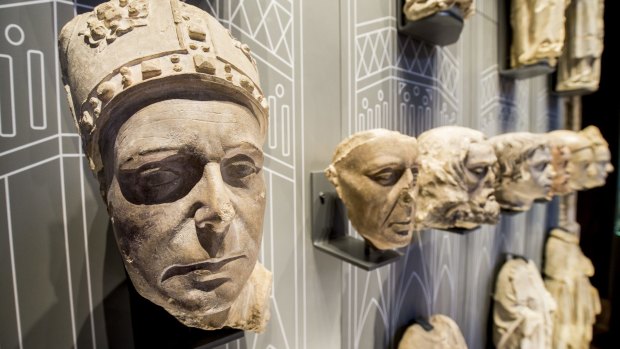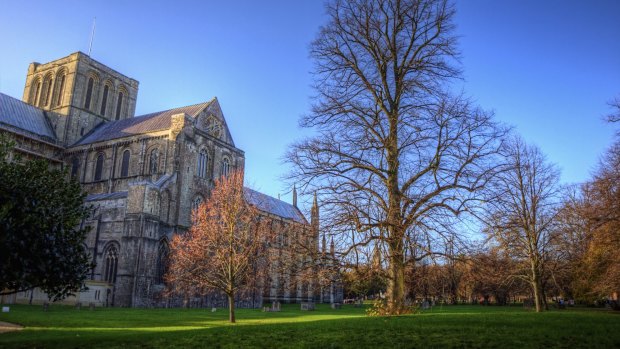This was published 4 years ago
Remains of England's lost queen Emma of Normandy found
By Mark Chipperfield

The Kings and Scribes: The Birth of a Nation exhibition at Winchester Cathedral. Credit: Robin Jones
Seven years after the remains of Richard III were discovered under a Leicester carpark, another legendary but lost English monarch has turned up in Hampshire.
Emma of Normandy, twice crowned Queen of England and the mother of Edward the Confessor, was interred in Winchester's Old Minster in 1052 and was later transferred to the newly built Winchester Cathedral.
Queen Emma, a powerful figure in late Saxon England, lay peacefully in a mortuary chest high above the cathedral choir for 600 years until the English Civil War.

Winter trees under clear blue sky with ancient Winchester Cathedral in background.
Oliver Cromwell's New Model Army had a particular loathing for Winchester, a Royalist stronghold, and once they had conquered the city set about vandalising its magnificent Gothic cathedral – the longest in Europe.
As well as stabling their horses in the nave, Cromwell's troops fired their muskets at its royal statues, pulled down six mortuary chests (including the one containing Queen Emma) and smashed the medieval glass windows.
"Cromwell's troops used the bones taken from the mortuary chests to smash the stained glass windows. It was their reaction against privilege and religious iconography," explains Catherine Hodgson, the cathedral's marketing manager. "Later the bones were returned to the mortuary chests, but everything was jumbled up."
A major project to restore the six mortuary chests now seems to have unlocked the mystery of Queen Emma's whereabouts – while final radiocarbon testing is continuing, a team of biological anthropologists from the University of Bristol is confident that one skeleton is indeed the long-departed English consort.
"Some more bone fragments have been sent off to Oxford University for further carbon dating, but we are hopeful that we have indeed located Queen Emma," says Catherine.
So hopeful, in fact, that a 3D printed replica of the queen's skeleton now forms the centrepiece of a permanent new exhibition, Kings and Scribes: The Birth of a Nation, which tells the story of Winchester Cathedral and its role in shaping the English national identity.
While Queen Emma does not enjoy the high public profile of Shakespeare's kings and queens, historians stress that she was a major political player in Anglo-Saxon England, whose influence extended to Normandy and Scandinavia.
"Emma is the only English monarch to be crowned twice, was the mother of two kings (Edward the Confessor and Harthacnut) and great aunt of William the Conqueror," says Catherine.
Apart from the glass cabinet displaying Queen Emma's bones, the new £11.2 million exhibition contains many of the cathedral's treasures, a detailed description of how it was built and a tribute to William Walker, the deep sea diver who helped stabilise the cathedral's crumbling foundations in the early 1900s.
Locals believe that the discovery of Queen Emma will bolster Winchester's claim to being the birthplace of the English nation. Founded by the Romans in AD43, the city counts Alfred The Great, King of Wessex, as one of its most famous sons. Winchester remained a centre of political and ecclesiastical power until the 12th century when the royal court, and mint, moved to London.
Just 75 minutes by train from London Waterloo, Winchester is already a popular destination for devotees of the novelist Jane Austen – she lived at nearby Chawton and is buried in the Cathedral – but many people come here just to soak up the atmosphere of a traditional market town which offers high-end shopping, a thriving street market, and plenty of fine dining; Brasserie Blanc, Rick Stein, The Ivy and River Cottage Kitchen are just some of the options.
While the cathedral, with its delicate vaulted ceiling, Great Screen and Antony Gormley sculpture in the crypt, remains the city's biggest tourist drawcard, make time to stroll along the River Itchen and visit the picturesque city watermill. Apart from the mill's 1000 years of history, the crystal clear waters are home to a small family of otters.
Trip Notes
FLY
British Airways flies from both Sydney and Melbourne to London Heathrow, via Singapore. See britishairways.com
STAY
Hotel du Vin & Bistro is a fine Queen Anne townhouse five minutes' walk from Winchester's main tourist attractions. The property offers 19 bold, contemporary rooms and suites, a private courtyard and an elegant French-style restaurant; the four-course Sunday lunch is great value. Garden Doubles from £175 ($314) a night, not including breakfast. See hotelduvin.com/locations/winchester
VISIT
Kings and Scribes: The Birth of a Nation, a multi-media exhibition over three levels, is located in the South Transept of Winchester Cathedral. The exhibition is open daily. Adult entry is £9.50 ($13.40). Tower tours are also available. visitwinchester.co.uk.
MORE
Mark Chipperfield visited Winchester at his own expense.
Sign up for the Traveller Deals newsletter
Get exclusive travel deals delivered straight to your inbox. Sign up now.